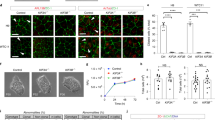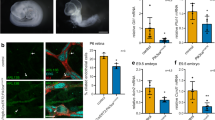Abstract
Cilia are hair-like organelles extending from the cell surface with important sensory and motility functions. Ciliary defects can result in a wide range of human diseases known as ciliopathies. However, the molecular mechanisms controlling ciliogenesis remain poorly defined. Here we show that cylindromatosis (CYLD), a tumor suppressor protein harboring deubiquitinase activity, plays a critical role in the assembly of both primary and motile cilia in multiple organs. CYLD knockout mice exhibit polydactyly and various ciliary defects, such as failure in basal body anchorage and disorganization of basal bodies and axenomes. The ciliary function of CYLD is partially attributed to its deconjugation of the polyubiquitin chain from centrosomal protein of 70 kDa (Cep70), a requirement for Cep70 to interact with γ-tubulin and localize at the centrosome. In addition, CYLD-mediated inhibition of histone deacetylase 6 (HDAC6), which promotes tubulin acetylation, constitutes another mechanism for the ciliary function of CYLD. Small-molecule inhibitors of HDAC6 could partially rescue the ciliary defects in CYLD knockout mice. These findings highlight the importance of protein ubiquitination in the modulation of ciliogenesis, identify CYLD as a crucial regulator of this process, and suggest the involvement of CYLD deficiency in ciliopathies.
Similar content being viewed by others
Log in or create a free account to read this content
Gain free access to this article, as well as selected content from this journal and more on nature.com
or
References
Goetz SC, Anderson KV . The primary cilium: a signalling centre during vertebrate development. Nat Rev Genet 2010; 11:331–344.
Seeley ES, Nachury MV . The perennial organelle: assembly and disassembly of the primary cilium. J Cell Sci 2010; 123:511–518.
Ishikawa H, Marshall WF . Ciliogenesis: building the cell's antenna. Nat Rev Mol Cell Biol 2011; 12:222–234.
Nigg EA, Raff JW . Centrioles, centrosomes, and cilia in health and disease. Cell 2009; 139:663–678.
Oh EC, Katsanis N . Cilia in vertebrate development and disease. Development 2012; 139:443–448.
Kobayashi T, Dynlacht BD . Regulating the transition from centriole to basal body. J Cell Biol 2011; 193:435–444.
Hao L, Scholey JM . Intraflagellar transport at a glance. J Cell Sci 2009; 122:889–892.
Yuan S, Sun Z . Expanding horizons: ciliary proteins reach beyond cilia. Annu Rev Genet 2013; 47:353–376.
Sun SC . CYLD: a tumor suppressor deubiquitinase regulating NF-kappaB activation and diverse biological processes. Cell Death Differ 2010; 17:25–34.
Gao J, Huo L, Sun X, et al. The tumor suppressor CYLD regulates microtubule dynamics and plays a role in cell migration. J Biol Chem 2008; 283:8802–8809.
Wickstrom SA, Masoumi KC, Khochbin S, Fassler R, Massoumi R . CYLD negatively regulates cell-cycle progression by inactivating HDAC6 and increasing the levels of acetylated tubulin. EMBO J 2010; 29:131–144.
Yang Y, Liu M, Li D, et al. CYLD regulates spindle orientation by stabilizing astral microtubules and promoting dishevelled-NuMA-dynein/dynactin complex formation. Proc Natl Acad Sci USA 2014; 111:2158–2163.
Jin W, Chang M, Paul EM, et al. Deubiquitinating enzyme CYLD negatively regulates RANK signaling and osteoclastogenesis in mice. J Clin Invest 2008; 118:1858–1866.
Trompouki E, Tsagaratou A, Kosmidis SK, et al. Truncation of the catalytic domain of the cylindromatosis tumor suppressor impairs lung maturation. Neoplasia 2009; 11:469–476.
Wright A, Reiley WW, Chang M, et al. Regulation of early wave of germ cell apoptosis and spermatogenesis by deubiquitinating enzyme CYLD. Dev Cell 2007; 13:705–716.
L'Hernault SW, Rosenbaum JL . Chlamydomonas alpha-tubulin is posttranslationally modified by acetylation on the epsilon-amino group of a lysine. Biochemistry 1985; 24:473–478.
Trompouki E, Hatzivassiliou E, Tsichritzis T, Farmer H, Ashworth A, Mosialos G . CYLD is a deubiquitinating enzyme that negatively regulates NF-kappaB activation by TNFR family members. Nature 2003; 424:793–796.
Shiratsuchi G, Kamiya R, Hirono M . Scaffolding function of the Chlamydomonas procentriole protein CRC70, a member of the conserved Cep70 family. J Cell Sci 2011; 124:2964–2975.
Wilkinson CJ, Carl M, Harris WA . Cep70 and Cep131 contribute to ciliogenesis in zebrafish embryos. BMC Cell Biol 2009; 10:17.
Shi X, Sun X, Liu M, Li D, Aneja R, Zhou J . CEP70 protein interacts with gamma-tubulin to localize at the centrosome and is critical for mitotic spindle assembly. J Biol Chem 2011; 286:33401–33408.
Butler KV, Kalin J, Brochier C, Vistoli G, Langley B, Kozikowski AP . Rational design and simple chemistry yield a superior, neuroprotective HDAC6 inhibitor, tubastatin A. J Am Chem Soc 2010; 132:10842–10846.
Kozikowski AP, Tapadar S, Luchini DN, Kim KH, Billadeau DD . Use of the nitrile oxide cycloaddition (NOC) reaction for molecular probe generation: a new class of enzyme selective histone deacetylase inhibitors (HDACIs) showing picomolar activity at HDAC6. J Med Chem 2008; 51:4370–4373.
Hiraki M, Nakazawa Y, Kamiya R, Hirono M . Bld10p constitutes the cartwheel-spoke tip and stabilizes the 9-fold symmetry of the centriole. Curr Biol 2007; 17:1778–1783.
Nakazawa Y, Hiraki M, Kamiya R, Hirono M . SAS-6 is a cartwheel protein that establishes the 9-fold symmetry of the centriole. Curr Biol 2007; 17:2169–2174.
Shi X, Wang J, Yang Y, Ren Y, Zhou J, Li D . Cep70 promotes microtubule assembly in vitro by increasing microtubule elongation. Acta Biochim Biophys Sin (Shanghai) 2012; 44:450–454.
Shi X, Liu M, Li D, Wang J, Aneja R, Zhou J . Cep70 contributes to angiogenesis by modulating microtubule rearrangement and stimulating cell polarization and migration. Cell Cycle 2012; 11:1554–1563.
Pugacheva EN, Jablonski SA, Hartman TR, Henske EP, Golemis EA . HEF1-dependent Aurora A activation induces disassembly of the primary cilium. Cell 2007; 129:1351–1363.
Sanchez de Diego A, Alonso Guerrero A, Martinez AC, van Wely KH . Dido3-dependent HDAC6 targeting controls cilium size. Nat Commun 2014; 5:3500.
Zhang Y, Kwon S, Yamaguchi T, et al. Mice lacking histone deacetylase 6 have hyperacetylated tubulin but are viable and develop normally. Mol Cell Biol 2008; 28:1688–1701.
Gao YS, Hubbert CC, Lu J, Lee YS, Lee JY, Yao TP . Histone deacetylase 6 regulates growth factor-induced actin remodeling and endocytosis. Mol Cell Biol 2007; 27:8637–8647.
Nozawa YI, Lin C, Chuang PT . Hedgehog signaling from the primary cilium to the nucleus: an emerging picture of ciliary localization, trafficking and transduction. Curr Opin Genet Dev 2013; 23:429–437.
Mans DA, Voest EE, Giles RH . All along the watchtower: is the cilium a tumor suppressor organelle? Biochim Biophys Acta 2008; 1786:114–125.
Massoumi R . CYLD: a deubiquitination enzyme with multiple roles in cancer. Future Oncol 2011; 7:285–297.
Eguether T, Ermolaeva MA, Zhao Y, et al. The deubiquitinating enzyme CYLD controls apical docking of basal bodies in ciliated epithelial cells. Nat Commun 2014; 5:4585.
Li D, Sun X, Zhang L, et al. Histone deacetylase 6 and cytoplasmic linker protein 170 function together to regulate the motility of pancreatic cancer cells. Protein Cell 2014; 5:214–223.
Reiley WW, Zhang M, Jin W, et al. Regulation of T cell development by the deubiquitinating enzyme CYLD. Nat Immunol 2006; 7:411–417.
Acknowledgements
We thank Xueliang Zhu for discussion, Shiyi Guo, Di An, Ruming Liu, Long Miao, and Chuanmao Zhang for technical assistance, and Tso-Pang Yao and Steven Y Cheng for reagents. This work was supported by grants from the National Basic Research Program of China (2012CB945002) and the National Natural Science Foundation of China (31130015, 31271437, and 31371382).
Author information
Authors and Affiliations
Corresponding author
Additional information
( Supplementary information is linked to the online version of the paper on the Cell Research website.)
Supplementary information
Supplementary information, Figure S1
Polydactyly in CYLD knockout mice. (PDF 37 kb)
Supplementary information, Figure S2
Transmission electron microscopy images of the cross sections of axonemes in the tracheal epithelial cilia of CYLD knockout mice. (PDF 126 kb)
Supplementary information, Figure S3
Examination of the interaction between CYLD and Cep70 in different phases of the cell cycle and in vitro. (PDF 59 kb)
Supplementary information, Figure S4
CYLD interacts with HDAC6 and inhibits its activity toward tubulin deacetylation. (PDF 87 kb)
Supplementary information, Figure S5
CYLD regulates the Shh signaling. (PDF 110 kb)
Rights and permissions
About this article
Cite this article
Yang, Y., Ran, J., Liu, M. et al. CYLD mediates ciliogenesis in multiple organs by deubiquitinating Cep70 and inactivating HDAC6. Cell Res 24, 1342–1353 (2014). https://doi.org/10.1038/cr.2014.136
Received:
Revised:
Accepted:
Published:
Issue date:
DOI: https://doi.org/10.1038/cr.2014.136
Keywords
This article is cited by
-
CYLD induces high oxidative stress and DNA damage through class I HDACs to promote radiosensitivity in nasopharyngeal carcinoma
Cell Death & Disease (2024)
-
Motile cilia genetics and cell biology: big results from little mice
Cellular and Molecular Life Sciences (2021)
-
Targeting the photoreceptor cilium for the treatment of retinal diseases
Acta Pharmacologica Sinica (2020)
-
O-GlcNAc transferase regulates centriole behavior and intraflagellar transport to promote ciliogenesis
Protein & Cell (2020)
-
Role of tubulin acetylation in cellular functions and diseases
Medical Molecular Morphology (2020)



